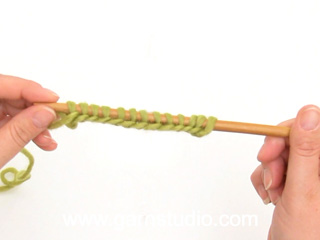How to cast on

There are several ways of casting on. We have chosen to show you the most common way that results in a firm yet stretchy edge.
It’s important that the casting on is not too tight. Do you feel that the edge is becoming too tight it’s always a possibility to change to a larger needle or to cast on over two needles. But don’t forget to change back to the original needles when you start knitting.
Figure 1: Begin by measuring a long tail from the end of the working yarn (the length varies depending on how many stitches you want to cast on, the yarn and size of the needle). Hold the tail of the yarn with your thumb and wind the yarn around your index and middle finger.
Figure 2: Pull the working yarn through the loop around your index and middle finger from behind and towards yourself.
Figure 3: Pull the loop to make a long stitch.
Figure 4: Place the stich onto the knitting needle and pull the yarn tails to tighten the stitch. You are now ready to cast on.
Figure 5: Place the yarn tail around your left thumb as seen on the photo. Slide the yarn strand over your left index finger and hold the two yarn strands in place in the palm of your hand using your ring and little finger.
Figure 6: Bring the right hand needle tip under the strand on your thumb.
Figure 7: To create the stitch, use the right hand needle tip and bring the strand from the working yarn (the yarn on your index finger) through the loop created by the thumb.
Figure 8: Drop the loop off the thumb onto the right hand needle. You have now cast on one new stitch. Tighten the stitch and pick up the thread with your thumb again. Continue in the same way until all stitches has been cast on.














This is the best cast on for sleeve and band edges, in my opinion. I hadn't knitted in a while, so I appreciate the clear instructions to jog my memory. 😊
09.12.2024 - 21:44